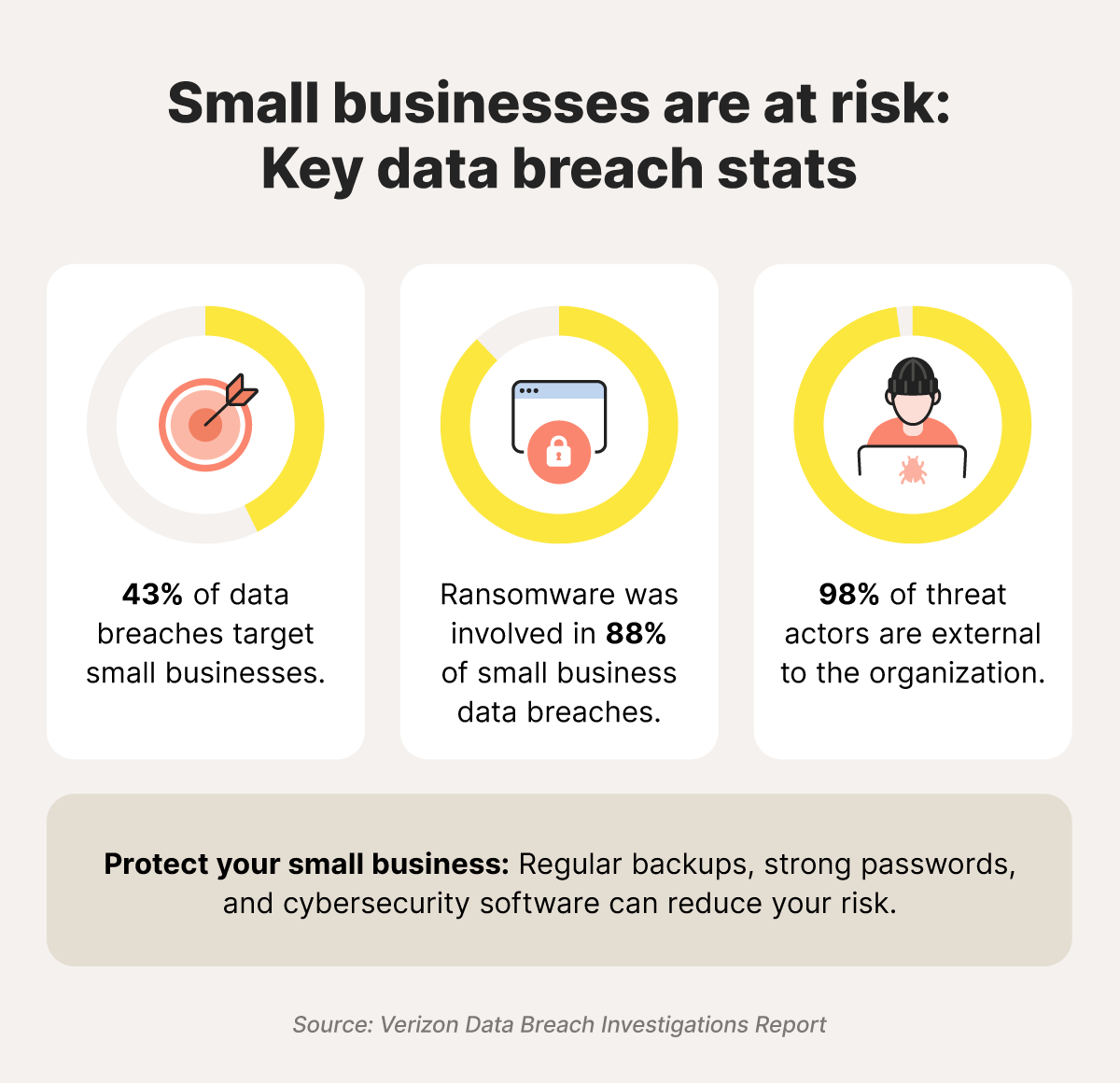Small business data breaches: What they are and how to stay ahead
A small business data breach happens when hackers steal, leak, or lock up sensitive company information that can cost you money, trust, and time. But there are ways to help protect yourself and your company.

Starting your own business is no small feat. You’ve poured your time, energy, and resources into getting it off the ground, so the last thing you want is for all of it to be compromised by a small business data breach. In fact, 43% of data breaches target small businesses, making them a prime focus for cybercriminals.
The IRS has also warned that cybercriminals frequently go after small business owners, with “thousands of attempts” reported, according to IRS Commissioner Danny Werfel.
Why? Cybercriminals know small businesses often lack the security resources of larger companies, making them easier prey. But here’s the good news: You can fight back with simple, smart steps. This guide breaks down how data breaches happen, the real impact on your business, and what you can do today to help prevent one.
How small business data breaches start
Small business data breaches often start with the smallest mistake: clicking the wrong link, skipping a software update, or trusting the wrong vendor. That makes it easier for cybercriminals to exploit common gaps in protection. A vast majority of breaches are caused by external actors, showing that most attacks come from outside your organization rather than from insiders.
Here are the most common entry points:
Phishing scams and social engineering
Phishing emails are a social engineering scheme designed to trick people into revealing sensitive information, such as login credentials or payment info. They often look like they’re from legitimate sources, like banks, vendors, or even your own company.
Just like small business owners can fall for a phishing scam, employees need to be equally aware of these types of cyberattacks on small businesses to help spot them.
Malware and ransomware attacks
Malware is malicious software that sneaks into your systems. Ransomware is arguably the worst kind: cybercriminals lock up your files and demand payment to get them back. In fact, ransomware is involved in 88% of small business data breaches, making it one of the most common and damaging threats.
In February 2025, a ransomware group claimed they were behind a ransomware attack on the Sault Ste. Marie Tribe of Chippewa Indians, affecting health centers and various businesses. The group caused disruptions to the tribe’s infrastructure and claimed to have stolen 199 GB of files. The Sault Ste. Marie Tribes had to halt business operations for days to help stop the attackers.
Weak or stolen passwords
A weak password is a stolen password. Passwords like “123456” or “companyname2020” are an open door for bad actors. And if that password is reused across platforms, one leak means they’ve got access to everything.
KNP, a U.K. 158-year-old transport company, was subject to a ransomware attack in July 2025 by hackers who literally guessed an employee’s password. If that can happen to a well-established company, then smaller operations need to take data security for small businesses seriously.
Outdated or unpatched software
Outdated software doesn’t have the latest security updates, and cybercriminals actively scan for these software vulnerabilities. If your systems or plugins are outdated, they can exploit those gaps before you know they exist.
It’s important to note that software patches and updates directly respond to software vulnerabilities. Since companies use many apps to operate, it’s essential to keep up with all the updates.
Lost or stolen devices
Lost or stolen devices can be a major risk, especially if they aren’t password-protected. That laptop you left in the coffee shop? It could be a direct line to sensitive information, like customer data, financials, and business secrets, if it didn’t have encryption.
Third-party vendor vulnerabilities
Third-party vendor vulnerabilities are no joke. Even if you’ve locked down your systems, you could still get burned if a vendor doesn’t. Your data might be exposed through their platforms.
Infosys Limited recently settled a lawsuit for the 2023 attack that led to personal and business data being exposed, affecting around 6.5 million people. Clients from companies that used them as vendors, such as Bank of America, were among those affected.


What a breach could mean for your business
A data breach can impact your business in many ways, and the effects often snowball fast. And the attacks are more common than you might expect. In fact, according to a 2024 KPMG survey, 40% of executives reported being subject to a cyberattack resulting in a security breach.
Potential consequences include:
- Financial hit: The average cost of business data breaches varies greatly from company to company. However, according to IBM, the global average cost is around $4.4 million.
- Reputation damage: Customers may lose trust, especially if their personal data is compromised.
- Downtime and disruption: You may lose access to systems, forcing your business to halt operations.
- Compliance and legal fallout: Depending on your industry, failing to protect data might result in legal consequences or penalties.
Your small business breach prevention plan
You don’t necessarily need a massive IT department to secure your business. Start here:
- Train your team: Employees are your first line of defense. Teach them to spot phishing, avoid suspicious downloads, and use secure practices.
- Use strong passwords and MFA: Require strong, unique passwords and turn on multi-factor authentication (MFA) wherever possible.
- Keep software updated: Set devices to auto-update so you never miss a critical patch.
- Secure your network. Use firewalls and encryption to keep intruders out.
- Use a VPN on public Wi-Fi: A VPN helps secure internet traffic on unsecured networks, like public Wi-Fi.
- Back up your data: Use both cloud and local backups. It’s your best recovery method if ransomware strikes.
- Limit access: Give team members access only to the data they need.
- Add business-grade protection: A solution like Norton Small Business can help protect all your devices and systems with one comprehensive plan.
Keep your business running strong and secure
Running a business is hard enough. Don’t let a preventable cyberattack bring it down. With smart steps and the right protection, like Norton Small Business, you can stay ahead of bad actors and help keep your data, customers, and reputation safe.
Norton Small Business provides comprehensive peace of mind with tools like Software Updater, a secure browser, and dark web monitoring — all in one robust cybersecurity suite.
FAQs
How can I tell if my small business had a data breach?
Watch for strange activity, like password reset emails, unauthorized logins, or locked files. Sudden system slowdowns or ransomware messages are also red flags.
What should I do first after a small business data breach?
Your first step is to contain the issue. Disconnect affected systems, change passwords, and contact a cybersecurity expert. Document everything for reporting and recovery.
Do I need to notify customers after a small business data breach?
In most cases, it’s legally required to notify customers of a data breach, especially if their personal or payment info was exposed. Check state and federal laws, which often require notification. Remember that transparency helps rebuild trust.
Editorial note: Our articles provide educational information for you. Our offerings may not cover or protect against every type of crime, fraud, or threat we write about. Our goal is to increase awareness about Cyber Safety. Please review complete Terms during enrollment or setup. Remember that no one can prevent all identity theft or cybercrime, and that LifeLock does not monitor all transactions at all businesses. The Norton and LifeLock brands are part of Gen Digital Inc.







Want more?
Follow us for all the latest news, tips, and updates.